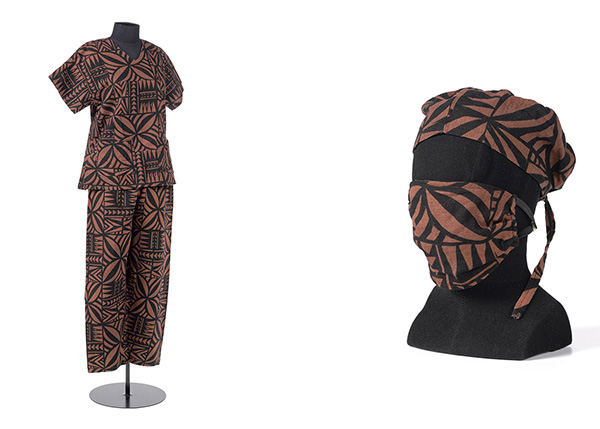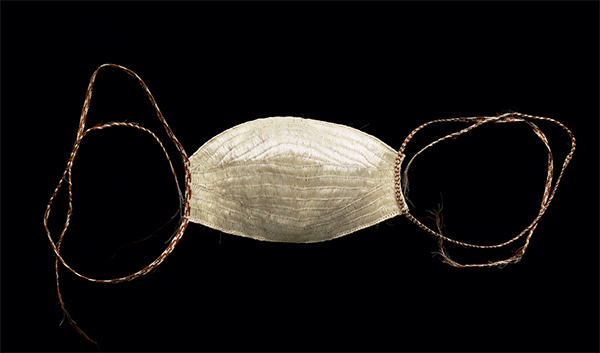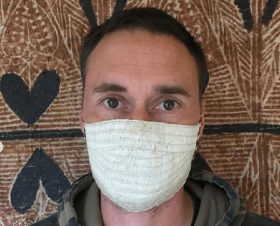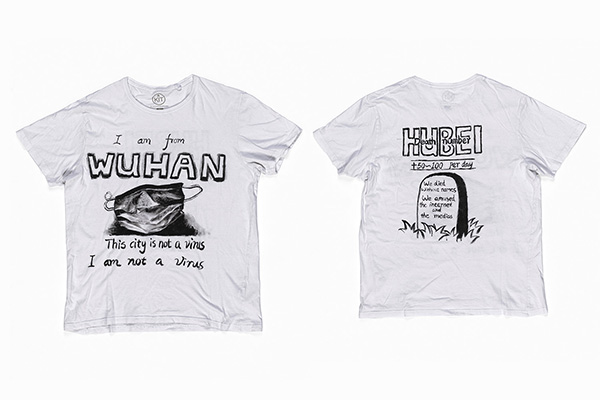A year since lockdown: Collecting to tell the story of Covid-19, Te Papa, 25 March 2021
It’s been a year since Aotearoa New Zealand went into lockdown in a move to restrict the spread of Covid-19. During this month-long period, people sought to process the magnitude of what was happening through creative expression and entrepreneurial adaptations. Since then, many organisations across the country have been collecting from this time to help tell the story of the Covid-19 pandemic.
The National Library of New Zealand Te Puna Mātauranga o Aotearoa has brought together many of these stories – from South Canterbury to Auckland – on their website, including contributions from us.
We’ve excerpted our contributions below. A link to the full piece on the National Library’s website is at the end.
Scrubs made from puletasi leftovers

These Poly scrubs were worn by Dr Shavonne Duffy, a General Practitioner based in Tāmaki Auckland. Staff were encouraged to wear medical scrubs as a means of protecting themselves and their wider whānau from contracting Covid-19. At the time Shavonne did not have her own. Her mother, Lolita Asopesio Duffy, made these scrubs with leftover material from the puletasi (Sāmoan two-piece formal dress) she had made for her daughter’s graduation a couple of years earlier.
Recounting her experiences of lockdown last year, Shavonne shares:
Initially, I was terrified for my patients, my colleagues, and for my family. We could see what was happening in northern Italy. My concern at the time was that New Zealand would be put in the same situation. If Covid infiltrated the community, it would be catastrophic.
We were advised by the Royal New Zealand College of General Practitioners that we should aim to have 70% of our consults via phone/virtual consults. We had to change the way we delivered healthcare. We transitioned from having a busy waiting room and seeing patients face to face, to phone triaging, phone consultations, and screening every person who walked through the doors.
Some of the fears and challenges of this period included patients being frightened to go to hospital and exposing themselves to Covid, concerns of the financial impact for our patients and their whānau, whilst trying to provide safe health care, and minimising risk to our staff and patients.
These scrubs help us tell the stories of essential workers, the changes and difficulties for those working and using health services, and the uptake in the use of Personal Protective Equipment (PPE).
– Rachel Yates, Curator Pacific Cultures
Face mask made from muka (flax fibres)

This is a muka face mask made during the Level 4 Covid-19 rāhui by artist Matthew McIntyre-Wilson (Ngā Mahanga, Titahi, Taranaki). At the start of March, Matthew was in Sydney with a delegation of Māori students and staff from Massey University attending events related to the recently-opened Biennale. As the impact of the pandemic became more immediate in Aotearoa, the trip was cut short and the delegation returned to Aotearoa to begin a period of self-isolation together.
It was at this point that Matthew conceived at began to create the muka face mask. During this period of self-isolation, it was announced that the country was entering into Alert Level 3 for 48 hours before entering Alert Level 4 for four weeks. This was an unprecedented change but illustrates how swiftly the pandemic-related government directives were enacted, and these changes are also part of the story that contextualises the making of the muka face mask.
The muka face mask is made from almost entirely from aho poka of muka, short wefts that, when woven in a particular way, can mirror the concertina folds of a surgical mask. Matthew mentioned that he first got the idea for using this technique after seeing a surgical mask and believing that the aho poka technique (where there is no introduction or reduction of whenu) can be used to round the face in the same way as a surgical mask.

This technique also illustrates a metaphorical link to the kaitaka (a type of cloak) and pāke (a type of cape) and their ability to be used as protection. This is in reference to Ruhia Porutu’s well-known protection of Thomas McKenzie by throwing her kaitaka on him. It also references the impenetrability of pāke after they are submerged in water – their fibres then swell to fill any gaps.
After making the mask, Matthew shared two images of his mask response on his Instagram account. The first was of the work in progress accompanied by an explanation of the weaving technique he was using and where he learned of the technique:
“I have an interest in fine muka kākahu created in the 18th century and collected on Captain James Cook’s voyages to New Zealand. There is more to be learnt about the technologies used by Māori makers through making. To be able to study and repatriate the techniques used in these kākahu would be valuable to other makers, weavers, and academics in helping to understand more about the complexities of these objects.”
A further element of this mask are the taura (cords) that will be used to secure the mask. These are woven in a nine-ply braid, some strands of which have been dyed with tānekaha using a cold-brewed technique. The braiding technique itself features two different patterns, which is a reference to kākahu (clothing) in overseas institutions (including a kaitaka paepaeroa in Edinburgh) where the kaitaka is bordered with braiding rather than tāniko (finger weaving).
– Matariki Williams, Curator Mātauranga Māori
‘I am from Wuhan’ T-shirt

This T-shirt was created by Chinese New Zealand artist Cat Xiao in February 2020. She made the shirt at her home in Christchurch and subsequently shared it on her Instagram feed under the internationally-recognised #iamnotavirus hashtag. At the time, the majority of reported deaths from Covid-19 were from mainland China.
As a Chinese New Zealander originally from Wuhan, Cat maintains strong connections with friends and family in China and was in regular contact with them from the very earliest months of the pandemic. She says she made the shirt in response to a lack of empathy for victims evident in much online coverage and on social media.
One of my friends lost her mother and couldn’t get to see her for a proper goodbye, couldn’t even have her relics, everything was burnt in an incinerator. But at that stage when the world was not alerted, their tragedies were just another story for the internet residents to consume. I made this T-shirt to tell others that behind the masks there are lives being lost, families being torn apart and cities losing their backbones.
Cat’s shirt is revealing of the ways in which, in an increasingly globalised world, many New Zealanders’ experiences of the pandemic have been deeply entangled with those of loved ones overseas. It also reminds us of the ways in which digital technologies have undermined notions of strict geographical boundaries.
This shirt was collected as part of Te Papa’s Making Sense of Pandemic project, aimed at capturing the ways in which ethnic Chinese living in Aotearoa have mediated their pandemic experiences on- and offline. Te Papa’s Making Histories programme, launched last month, also explores different experiences of the Covid-19 pandemic through a mix curatorial, digital and public activities.
– Grace Gassin, Curator Asian New Zealand Histories
Read the full blog, ‘Documenting Covid-19: One year on’, on the National Library website, bringing together stories of Covid-19 collecting from organisations across the country.
See also: Kowheori-19 │ Covid-19

